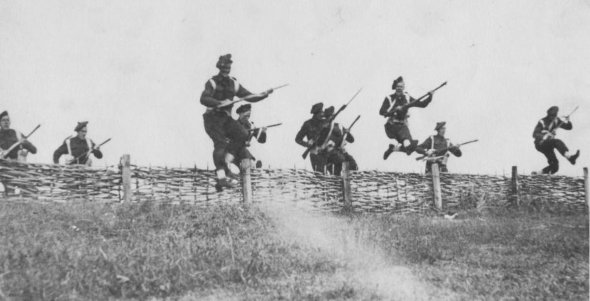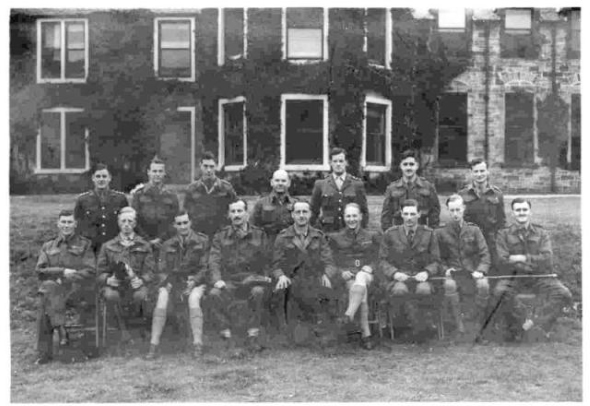A timeline of Commando Training
Primary tabs
The first call for volunteers for ‘Service of a hazardous nature’ was in the early months of 1940 and for the new Independent Companies. Many of these men went onto action in Norway almost immediately with little training. On their return Winston Churchill wanted his own Corps of ‘shock troops’ to start afresh. Lt Col Dudley Clarke, who was then Military Assistant to the Chiefs of the Imperial General Staff, is generally credited with the initial outline plan of their formation. His plan was approved and the name agreed on. Thus the ‘Commandos’ were formed.
A Combined Training Centre (CTC) at Inverary and a Special Training Centre (STC) at Lochailort (see above photo) had been established. The latter consisted of Nissen huts and tents, with the headquarters installed in Inverailort Castle, about 27 miles West of Fort William. A powerful team of instructors were gathered there, with many going on to became well known leaders of irregular forces, including the Chindits and Special Air Service, all being formed after the Commandos. The Instructors included Lord Lovat, Brigadier 'Mad Mike' Calvert, Colonel Spencer Chapman, Major Peter Kemp, and the Sirling brothers Bill and David.
Additionally other Officers and NCO's with a wide range of experiences from arctic exploring to rugged campaigning on the North West frontier of India, plus those well versed in signalling, demolitions, and shooting. Two of these Instructors were Messrs Fairbairn and Sykes of Shanghai Police fame. These two men, more than anyone else in the British Army were responsible for the introduction of unarmed combat and close quarter fighting.
From July 1940 Officers and selected NCO's from the newly formed Commandos attended STC courses, and then returned to blend the techniques and skills acquired with the other new ideas being developed within the training regime of their own Commandos.
The castle of Achnacarry, and the grounds, was the seat of Sir Donald Walter Cameron of Lochiel, Chief of the Scottish Clan Cameron, who in June 1940 had given hospitality to No. 1 Independent Company. In December 1940, Achnacarry, as well as nearby Achdalieu Lodge, were officially brought into use as part of the the new Training and Holding Wing for the Special Training Centre (S.T.C.) and remained as such for the next year.
A decision was made to centralise all Commando training at Achnacarry. In December 1941 Achnacarry was re-designated as The Commando Depot, and passed under the authority of the Special Service Brigade. The first courses began in the months of February/March 1942. Achnacarry was now the training centre for all Commandos in the UK and was still known as the Commando Depot but later re-designated as the Commando Basic Training Centre.
For Commandos already deployed overseas, additional training areas were set up including the Training and Holding Unit at Geneifa beside the Great Bitter Lake in the Middle East
The first Commandos were all Army Commandos. Twelve Army Commandos were raised in 1940 and had been involved in operations since then.
It was not until February 1942 that the first Royal Marine Commando unit was raised, initially designated as the 'Royal Marine Commando', then redesignated 'A' RM Commando when a second RM Commando was formed in October 1942, before finally being designated as 40 Royal Marine Commando, Royal Marines. Nine RM Commando units were in existence by the end of the war.
There were also Royal Naval Beach Commandos and RAF Servicing Commandos, and groups given Commando designations for a limited period or a specific purpose, some examples being No.14 Commando, No.62 Commando, and 142 Commando Company.
View a Roll of Honour of those who died at training centres: WW2 Training Centre Deaths
Read about the origins of the green beret here: History of the Commando Green Beret
Read about the origins of the fighting knife here: History of the Commando Fighting Knife
View a brief outline on this link to other Commando Training Centres from their formation until the present time.
- Donald Gilchrist, CBTC Instructor and author of Castle Commando.
- James Dunning, CBTC Instructor and author of It Had To Be Tough.
- Commando Veterans Archive Gallery
- The No 10 Independent Company War Diary
Read on from below right ......
Ask Questions / Add Information / Add Photos
Read some frequently asked questions here [FAQ's].




